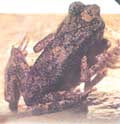| A
guide to the eighteen genera of amphibians of Sri Lanka
Amphibians
of Sri Lanka
Sri Lanka’s
rich amphibian fauna presently consists of 59 species 70% of which
are endemic to the country. In addition to this impressive inventory,
approximately another one hundred species await formal description.
With almost four amphibian species per1000 square-kilometers, this
is the highest amphibian “species density” in the world’
, even when compared to the world’s so-called “mega
diversity countries”.
The amphibians
of Sri Lanka belong to four families: Bufonidae, Microhylidae, Ranidae
and Ichthyophiidae. The amphibians live in various ecological niches
such as fossorial, terrestrial, arboreal and aquatic. Majority of
Sri Lankan frogs reproduce by laying eggs among moist leaf litter
(direct development), some make a spawn above a water source into
which they deposit their eggs, whilst some deposit their eggs in
water.
Frogs are an
important group of animals. They play an important role by feeding
on insects; additionally , their toxins are used in medical and
biological and research, their skin secretions containing valuable
medical compounds. They also add to Sri Lanka’s remarkable
biological and genetic diversity. Frogs are considered the best
biological indicators of environmental pollution. (To
be continued next week)
Key:
A.l-average length, M-male, F-female.
| 
Kaloula
taprobanica, Parker, 1934. Common bull frog. A. l.: M = 30
mm, F = 50 mm,
Status: Not endemic, Lower Risk. |

Bufo
melanostictus, Schneider, 1799.
House toad. A. l.: M = 50 mm, F = 70 mm,
Status: Not endemic, Lower Risk.
|

Microhyla zeylanica, Parker and Hill, 1949. Sri Lanka. narrow
mouth frog, A.I.: M = 17 mm, F = 20 mm,
Satus: Endemic, Endangered
|

Microhyla
ornatus, (Dumeril and Bibron, 1841 ) Ornate narrow mouth frog.
A. l.: M = 20 mm, F = 25 mm, Status: Not Endemic, Lower Risk. |

Ramanella
obscura, ( Gunther , 1864) .
Grey-brown pug snout frog, A.I.: M = 25 mm, F = 30 mm, Status:
Endemic, Lower Risk.
|

Uperodon
systoma, (Schneider, 1799)
Balloon frog,A. I.: M = 45 mm, F = 55 mm,
Status: Not endemic, Lower Risk.
|

Ramanella
variegata, (Stoliczka, 1872)
White-bellied pugsnout frog, A.l.: M = 25 mm, F = 30 mm, Status:
Not endemic, Lower Risk. |

Adenomus
kelaarlii, Gunther, “1858”,1859. Kelaart’s
smooth finger toad. A. I.: M = 25 mm, F = 40 mm. Status: Endemic,
Vulnerable. |

Bufo
atukoralei, Bogert & Senanayake, 1966.
Atukora dwarf toad.
A.I.: M = 20, mm F = 30 mm, Status: Endemic, Lower Risk.
|
|
|
|
Information
and photographs from
Ministry of Environment and Natural Resources/Anslem de Silva
Coordinated by Duminda Sanjeewa Balasooriya
|








